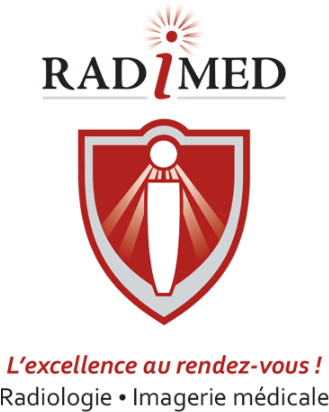Magnetic Resonance Imaging (MRI)
Magnetic Resonance Imaging is an imaging technique that uses a magnet to generate a magnetic field and thus obtain images of the human body. No radiation is produced. The patient lies on a table and the part of the body that is examined enters into the magnetic field. This is done safely and comfortably.
Images are then obtained of the body, and the part in question is examined in any plane. The resolution of the MRI is excellent for soft tissues in the body (in fact, the best of all imaging techniques). Therefore, it is the ideal imaging modality to evaluate the brain, the spinal cord, the abdominal organs (liver, kidneys, pancreas), and the genital organs. MRI is the imaging modality of choice to evaluate the musculoskeletal system. Thus, one can appreciate the different tendons and ligaments in all joints, and see the menisci in the knees.
When going for an MRI examination, you must answer a questionnaire to see whether there are any contraindications to undergoing such an examination, (for example, a pacemaker or metal shards in the eyes). When coming into an Magnetic Resonance Imaging suite, any metal you have (a ring, coins, etc.) is removed. If you are claustrophobic, our staff will take care of you to help you get through your examination.
The technologist installs a coil on the body part to be examined (e.g. the knee). This coil will produce detailed images in this area. During the examination, you may communicate at any time with the technologist via a microphone.
The studies last on average between 20 and 50 minutes. Some studies will require the injection of a contrast medium (dye) intravenously. Each examination produces an average of 100 images that one of our MRI radiologists will analyze. A prepared report will then be sent to your physician.
Radimed at Pointe-Claire has an MRI device for the examination of the extremities. This device is unique in Quebec. Only your wrist, elbow, knee or ankle penetrates into the small magnet while you are sitting in a very comfortable chair. The magnet is a miniature one but with the same magnetic force (1.5 Tesla) as the large magnet.
Questionnaire:
A questionnaire must be completed beforehand by you or your doctor stating the following elements: implants, jewelry and the presence of metal in your body. When making the appointment and then with the technologist, you will review the magnetic resonance compatibility questionnaire.
This questionnaire is very important for your safety as well as for the realization of good images (click HERE).
Remember to tell the technologist if you are pregnant.
Exam offered:
-
Abdominal MRI
Do not drink or eat anything 3 hours before the examination
-
Cardiac MRI
Fast 4 hours before the examination, no caffeine for 12 hours before.
-
MRI msk (musculoskeletal)
No preparation
-
MRI of the breasts
Breast cancer is the most common cancer among Canadian women after non-melanoma skin cancers. Breast cancer can also occur in men, but it is not as common. Breast cancer is formed in the cells of the breast; these cells are found in breast tissue, as well as the area between the clavicle (collarbone), underarm and sternum (breastbone).
MRI is indicative for:
– Evaluating the extent of known breast cancer for pre-operative
– Examine the spread of known breast cancer
– Screening for high risk patients
– Follow up for patients who have had breast cancer
– Pre-operative to help the surgeon plan for surgery
Do not wear deodorant or antiperspirant before the examination (bring your previous films and reports)
Do not drink or eat anything 3 hours before the examination
-
Neurological MRI
The preparation depends on the exam to be done so our staff will advise you of the necessary preparation when making an appointment
-
Pelvis MRI
Do not drink or eat anything 3 hours before the examination
-
MRI-cholangiography
MRCP is a dedicated MRI examination of the biliary ducts and system. This examination can help in identifying malformations and anatomical variants of the biliary ducts and assess pathologies of the biliary system.
This study can also detect the presence of gallstones or tumors of the biliary system. This MRI study also helps in assessing extrabiliary anomalies, i.e. within other organs such as the pancreas. It is a non invasive examination.Technique
The patient is lying on his back, with an antenna acting as a camera, placed on the front of the abdomen to see the different organs.
Small speakers are given to the patient so that he can listen to the instructions of the technologist especially to control his or her breathing, and to diminish the sound of the MRI machine. For most of the images, the patient must stop breathing for about 15-20 seconds.
We can sometimes inject a dye or contrast ferromagnetic agent such as gadolinium to complete the examination.
The examination lasts for about 30 minutes without contrast injection and 45 minutes with contrast injection.
Do not drink or eat anything 3 hours before the examination
-
Prostate MRI
Prostate cancer is a common occurrence in men similarly to breast cancer in women. However, men do not have the reliable screening tools, such as mammogram for women, for accurate detection of the disease.
A multiparametric magnetic resonance imaging of the prostate is a new, non-invasive and highly reliable technique in detecting prostate cancer. In addition to producing high resolution of the anatomy, this procedure evaluates the health of the vessels and the density of the cells. The procedure also allows reliable differentiation between clinically significant aggressive cancer and non-significant lesions. It is recommended to perform this procedure before a biopsy in order to focus more on areas visible on MRI, thereby reducing the possibility of non-essential detection benign cancers and differentiating between artefacts on specialized imaging. Biopsy targeted by MRI could limit unnecessary diagnosis and treatment.
Technique
The procedure is performed in the supine (lying on the back) position. A catheter, which is used to administer the contrast medium, is inserted into a vein in the arm or hand. An antispasmodic agent is injected intramuscularly through the biceps before the examination to decrease peristalsis of the intestines.
It is recommended to do the following before the examination:
- Refrain from sexual activities for 72 hours.
- Fast 4 hours before the examination (3 hours before leaving home).
- Administer a rectal enema (Fleet enema). This can be purchased at a pharmacy.
-
Dynamic pelvic floor MRI / Defeco MRI
Pelvic floor dysfunction (PFD) is a common disorder present in 25 percent of women aged 30 to 70 years. The diagnosis of PFD begins with a detailed collection of medical history and physical examination. When imaging is required, some doctors prefer a dynamic pelvic MRI in lieu of fluoroscopy.
Procedure
At first, the acquisition is carried out at rest followed by a trust sequence with evacuation.
It is, indeed, important to push until is a complete evacuation from the rectum is attained in order to have a clear image of any anomalies or shape and position of the rectum and other organs of the small pelvis.
At the end of the different sequences, a quick wash is performed before the patient gets dressed.
The technologist will insert a catheter (a small plastic tube) into the rectum and inject about 100ml of gel. The gel makes it easier to differentiate the organs. The gel, which is situated in the rectum, will be evacuated during the acquisition of the images. One the gel is inserted, the catheter is removed.
-
MRI Quantification of Iron Overload
Hemochromatosis is an inherited disease characterized by absorption of too much iron by the body through dietary intake, and it is among the more frequently occurring genetic diseases in Canada, affecting 1 in 300 Canadians. To contract this disease, you have to inherit two defective genes, one from each parent. A brother or sister has a 25 percent chance of having the disease.
It is important to have a non-invasive method to determine the degree of impairment. The most recent studies have shown that MRI can be used to determine iron level in the blood with an equivalency of what is determined by biopsy.
Different sequences are performed to morphologically analyze the liver, spleen and pancreas correctly and to locate any hypointense lesion in the liver. The total duration of a scan, including placing the patient in the machine, is approximately 15 minutes.
Early detection and treatment of hemochromatosis is essential in preventing complications from this potentially fatal disease.
Procedure
You will be placed in supine position (lying on your back), and the technologist will put a camera on you. You will be placed in the center of the machine. You will have to follow breathing instructions. It is important to follow the instructions. For each image, you will need to hold your breath for about 15 seconds.
No preparation is necessary.
-
MRI quantification of liver fat
This test helps to quantify the fat contents of the liver. During this test, the technologist obtains a series of special images then measures the liver in order to determine the percentage of fat
Procedure
You will be placed in supine position (lying on your back), and the technologist will place a camera on you. You will be placed in the center of the machine. It is important to follow the breathing instructions. For each image, you will need to hold your breath for about 15 seconds.
No preparation is necessary.





